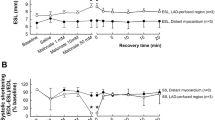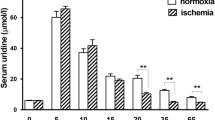Abstract
The effects of the intracoronary administration of isosorbide-2-mononitrate (ISMN; 3 μg kg−1 min−1), a major metabolite of isosorbide dinitrate, were examined in chloralose-urethane anaesthetized dogs before and during a 25 min, acute occlusion of the left anterior descending coronary artery. The only significant haemodynamic effects of ISMN administration were a slight (−11 ± 2 mmHg) decrease in arterial blood pressure and a decrease (<12%) in diastolic coronary vascular resistance. Coronary occlusion in the presence of ISMN led to a markedly reduced incidence and severity of ventricular arrhythmias compared to those in control, saline-infused dogs. There were fewer ectopic beats (62 ± 35 versus 202 ± 72; p < 0.05), a lower incidence (25% versus 75%; p < 0.05) and number of episodes (0.7 ± 0.4 versus 4.3 ± 2.1; p < 0.05) of ventricular tachycardia and fewer dogs fibrillated during the ischaemic period (17% versus 82%; p < 0.05). More dogs given ISMN survived the combined ischaemia-reperfusion insult (50% versus 0%; p < 0.05). Changes in ST-segment elevation (recorded by epicardial electrodes) and in the degree of inhomogeneity of electrical activation within the ischaemic area were much less pronounced throughout the occlusion period in dogs given ISMN. These results add weight to the hypothesis that the previously reported antiarrhythmic effects of ischaemic preconditioning, and of the intracoronary administration of nicorandil, involve nitric oxide.
Similar content being viewed by others
References
Végh Á, György K, Papp JGy, Parratt JR. Nicorandil suppresse ventricular arrhythmias in a canine model of myocardial ischaemia. Eur J Pharmacol 1996;305:163-168.
Végh Á, Papp JGy, György K, Kaszala K, Parratt JR. Does the opening of ATP-sensitive K+ channels modify ischaemiainduced ventricular arrhythmias in anaesthetised dogs? Eur J Pharmacol 1997;333:33-38.
Végh Á, Szekeres L, Parratt JR. Preconditioning of the ischaemic myocardium; involvement of the L-arginine nitric oxide pathway. Br J Pharmacol 1992;107:648-652.
Parratt JR, Végh Á. Endothelial cells, nitric oxide and ischaemic preconditioning. Basic Res Cardiol 1996;91:27-30.
Kis A, Végh A, Papp JGy, Parratt JR. Pacing-induced delayed protection against arrhythmias is attenuated by aminoguanidine, an inhibitor of nitric oxide synthase. Br J Pharmacol 1999;127:1545-1550.
Kis A, Végh A, Papp JGy, Parratt JR. Repeated cardiac pacing extends the time during which canine hearts are protected against ischaemia-induced arrhythmias: role of nitric oxide. J Mol Cell Cardiol 1999;31:1229-1241.
Parratt JR, Végh Á, Zeitlin IJ, et al. Bradykinin and endothelial-cardiac myocyte interactions in ischaemic preconditioning. Am J Cardiol 1997;80(3A):124A-131A.
Parratt JR, Végh Á. Coronary vascular endothelium, preconditioning and arrhythmogenesis. In: Lewis MJ, Shah AM, eds. Endothelial Modulation of Cardiac Function. Harwood Academic Publishers, Amsterdam 1997:237-255.
Kukovetz WR, Holzmann S, Romarin C. Mechanism of vasodilation by nitrates: role of cyclic GMP. Cardiology 1987;74 (suppl 1):12-19.
Sisenwine SF, Ruelius HW. Plasma concentration and urinary excretion of isosorbide dinitrate and its metabolites in the dog. J Pharmacol Exp Ther 1971;176:296-301.
Stauch M, Grewe N. Die Wirkung von Isosorbiddinitrat, Isosorbid-2-und 5-Mononitrat auf das Belastungs-EKG und auf die Hämodinamik während Vorhofsstimulation bei Patienten mit Angina Pectoris. Z Kardiol 1979;68:687-693.
Tauchert M, Jansen W. Development of mononitrates. Cardiology 1987;74(suppl. 1):3-5.
Pipilis A, Flather M, Collins R, et al. Effects on ventricular arrhythmias of oral captopril and of oral mononitrate started early in acute myocardial infarction: results of randomized placebo contolled trial. Br Heart J 1993;69:161-165.
Bogaert MG, Rosseel MT. Vascular effects of the dinitrate and mononitrate esters of isosorbide, isomannide and isoiodide. Arch Pharmacol 1972;275:339-344.
Wendt RL. Systemic and coronary vascular effects of the 2-and the 5-mononitrate esters of isosorbide. J Pharmacol Exp Ther 1972;180:732-742.
DeCaterina R, Lombardi M, Bernini W, et al. Inhibition of platelet function during in vivo infusion of isosorbide mononitrates: relationship between plasma drug concentration and hemodynamic effects. Am Heart J 1990;119:855-862.
DeCaterina R, Giannessi D, Mazzone A, Bernini W. Mechanism for the in vivo antiplatelet effects of isosorbide dinitrate. Eur Heart J 1988;9(suppl. A):45-49.
Strein K, Sponer G, Bartsch W, Müller-Beckman B, Dietmann K. Electrocardiographic analysis of the effects of isosorbide-5-mononitrate on regional myocardial ischemia in conscious dogs. J Pharmacol Exp Ther 1984;229:787-792.
Bacher S, Kraupp O, Beck A, Skoda H, Raberger G. Characterisation of vasodilators by comparison of their effects on blood pressure, counterregulation and myocardial oxygen demand in conscious normotensive dogs. Arzneim-Forch/Drug Res 1985;35:288-291.
Leitold Von M, Laufer H. Vergleichende antianginöse, hamodynamische und pharmakokinetische Wirkung von Isosorbid-2-mononitrat und Isosorbiddinitrat an der Ratte. Arzneim-Forsch/Drug Res 1983;33:1117-1121.
Végh Á, Komori S, Szekeres L, Parratt JR. Antiarrhythmic effects of preconditioning in anaesthetised dogs and rats. Cardiovasc Res 1992;26:487-495.
Kent KM, Smith ER, Redwood DR, Epstein SE. Beneficial electrophysiologic effects of nitroglycerin during acute myocardial infarction. Am J Cardiol 1974;33:513-516.
Stockmann MB, Verrier RL, Lown B. Effect of nitroglycerin on vulnerability to ventricular fibrillation during myocardial ischaemia and reperfusion. Am J Cardiol 1979;43:233-238.
Levites R, Boderheimer MM, Helfant RH. Electrophysiologic effects of NTG during experimental coronary occlusion. Circulation 1975;52:1050-1055.
Borer JS, Kent KM, Goldstein RE, Epstein SE. Nitroglycerin-induced reduction in the incidence of spontaneus ventricular fibrillation during coronary artery occlusion in dogs. Am J Cardiol 1974;33:517-520.
Margonato A, Bonetti F, Mailhac A, Vicedomini G, Cianflone C, Chierchia SL. Intravenous nitroglycerin suppresses exercise-induced arrhythmias in patients with ischaemic heart disease: implications for long-term treatment. Eur Heart J 1991;12:1278-1282.
Mihalick MJ, Rasmusson S, Knoebel SB. The effect of nitroglycerin on premature ventricular complexes in acute myocardial infarction. Am J Cardiol 1974;33:157(abstr).
Kane KA, Parratt JR, Williams FM. An investigation into the characteristics of reperfusion-induced arrhythmias in the anaesthetised rat and their susceptibility to antiarrhythmic agents. Br J Pharmacol 1984;82:349-357.
Barnes CS, Coker SJ. Failure of nitric oxide donors to alter arrhythmias induced by acute myocardial ischaemia or reperfusion in anaesthetized rats. Br J Pharmacol 1995;114:349-356.
Bilinska M, Maczewski M, Beresewicz A. Donors of nitric oxide mimic effects of ischaemic preconditioning on reperfusion-induced arrhythmias in isolated rat heart. Mol Cell Biochem 1996;160-161:265-271.
Marshall RJ, Parratt JR. Drug-induced changes in bloodflow in the acutely ischaemic canine myocardium: relationship to subendocardial driving pressure. Clin Exp Pharmacol Physiol 1974;1:99-112.
Végh Á, Papp JGy, Szekeres L, Parratt JR. The local administration of methylene blue prevents the pronounced antiarrhythmic effect of ischaemic preconditioning. Br J Pharmacol 1992;107:910-911.
Siegfried MR, Erhardt J, Rider T, Ma X-L, Lefer A. Cardioprotection and attenuation of endothelial dysfunction by organic nitric oxide donors in myocardial ischemia-reperfusion. J Pharmacol Exper Ther 1992;260:668-675.
Author information
Authors and Affiliations
Rights and permissions
About this article
Cite this article
György, K., Végh, Á., Rastegar, M.A. et al. Isosorbide-2-Mononitrate Reduces the Consequences of Myocardial Ischaemia, Including Arrhythmia Severity: Implications for Preconditioning . Cardiovasc Drugs Ther 14, 481–488 (2000). https://doi.org/10.1023/A:1007832921391
Issue Date:
DOI: https://doi.org/10.1023/A:1007832921391




